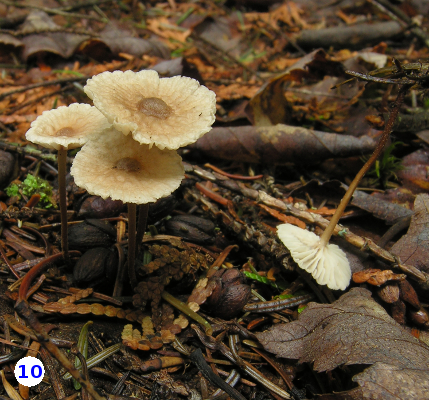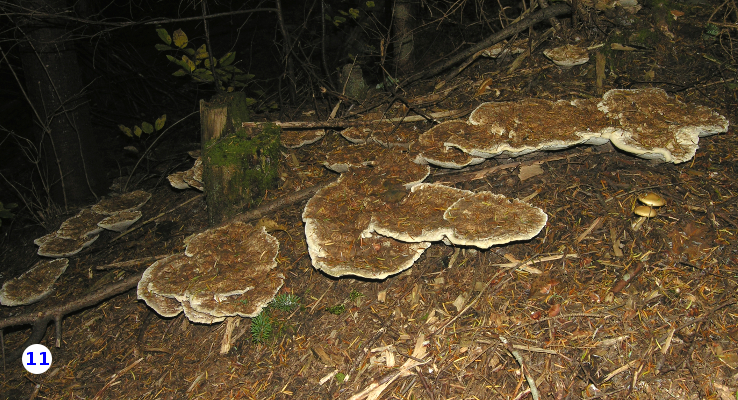ODOUR





There is no easy way to have a "scratch-and-sniff" web page to illustrate mushroom odours, yet the subject definitely demands attention. Many mushrooms have distinctive odours that help us greatly in identifying them. You will need this information if you are working with dried mushrooms, but, with some exceptions, it will not be available unless you have written it down. The approach taken here is to illustrate some common species having recognizable odours and discuss what you can expect and what you should record in your field notes.
The first line of illustrations contains photos of three mushrooms esteemed as food: 1) Cantharellus cibarius, the chantarelle; 2) Clitopilus prunulus, the miller or sweetbread mushroom; 3) Tricholoma dulciolens, one of the matsutake group of mushrooms. Chantarelles, when fresh, have a distinct odour of apricots that would be unmistakable even to a blindfolded collector. Clitopilus prunulus is one of many mushrooms having what is termed a farinaceous odour. By its definition farinaceous implies an odour of fresh meal or raw pastry, but to many people this odour is really more like cucumber or watermelon rind. Farinaceous odours are particularly characteristic of many species of Entoloma and Tricholoma. The odour of Tricholoma dulciolens is much harder to describe. Once you have smelled it you will remember it. It is quite strong and capable of filling a small room. To me it is reminiscent of Russian olive flowers but others disagree with this. We once had an old movie screen that smelled like that, but this is no help to anyone.
The second line of photos depict two species of Lactarius and an Inocybe. The mushroom in Panel 4 is Lactarius hibbardae, a North American relative of the European L. mammosus. If not overly dry the fruiting bodies of this species have a disinct and pleasant odour of coconut. Lactarius glyciosmus, a species found under birches, has a similar odour. Panel 5 depicts Lactarius camphoratus, a species with an odour described as resembling fenugreek (a major ingredient in curries). Canadians will immediately recognize this odour as resembling the artificial flavouring used in maple-leaf cookies, sold in all grocery stores. The fresh mushroom may not have this odour very pronounced, but it really intensifies when the mushroom is dried, and it persists in the herbarium for many years. Panel 6 is a photo of Inocybe lacera. The odour of many species of Inocybe, including I. lacera is the subject of much joking and some embarrassing or awkward moments. The name for this odour is spermatic because it fairly accurately duplicates the odour of human semen. If you are unfamiliar with this odour you might ask another collector to show you a mushroom having it, perhaps creating yet another awkward moment.
The third set contains three species of the large genus Cortinarius, a genus not usually known for distinctive odours. Panel 7 depicts C. traganus, a species with a distinct odour resembling dried apples or pears. The species name "traganus" refers to goats, which really do not smell at all like apples. Cortinarius camphoratus, in Panel 8, looks a lot like C traganus but has an unpleasant odour of rotten potatoes. You can often smell it before you find it. Odour easily distinguishes C. camphoratus from C. tranganus, but if you have a cold or other olfactory handicap you can use the colour of the young gills, brown vs. purple, to distinguish them. Cortinarius violaceus, in Panel 9, and the closely related C. hyrcinicus have a notable odour of cedar wood. I am unaware of any other mushrooms with this odour.
Panel 10 is a photo of Gymnopus perforans, a species we very commonly find on needle beds of spruce and fir. The crushed caps have a strong and rather unpleasant odour of rotting cabbage. Unmistakable! Other species of Gymnopus may have odours varying from pleasantly sweet to distinctly of garlic or onion.
Panel 11 is a photograph of a massive fruiting of Hydnellum suaveolens, one of the tooth fungi having an odour variously described as anise, peppermint, bath soap, etc. On a recent outing in New Brunswick a group of mycologists was able to detect the odour of this mushroom from a distance of nearly 100 meters and was able to follow the scent back to this group of fruiting bodies.
In all of this discussion I have not made any distictions regarding the location of mushroom odours. In fact, most people just break off a piece of cap, possibly crushing it, and then smelling. Some of the Scandinavian mycologists are much more precise than that. They comment on odours at the base of the stipe, from the flesh, from the gills and from a pile of fruiting bodies. They are of course quite justified in this. Many mushrooms have a distinct odour when enclosed in waxed paper or some other container, yet this does not seem to be present in the cut flesh. For example, the mushroom Pholiota squarrosoides grows in large clusters that have an odour somewhere between coffee and chocolate, yet the flesh totally lacks this odour. Other species of Pholiota give off an odour of green corn. As some mycologists have pointed out, the base of the stipe of some Cortinarius and Hebeloma species has an odour of honey not detectable on other parts of the mushroom. If you have a sensitive nose, see what you can detect.
TASTE
As noted in the section on latex there may be occasions when you might wish to record the taste of mushrooms. This could be risky if you swallow pieces of a poisonous species. The best advice is to avoid tasting mushrooms until you are experienced enough to recognize the really dangerous ones. When you do taste them, cut off a small piece and chew it at the front of your mouth until a taste appears, then spit it out. Tasting will be useful for Lactarius, Russula, Cortinarius, Gymnopilus and some other mushrooms that may have bitter or acrid (hot) flesh. Just be careful with this; if in doubt, don't taste!